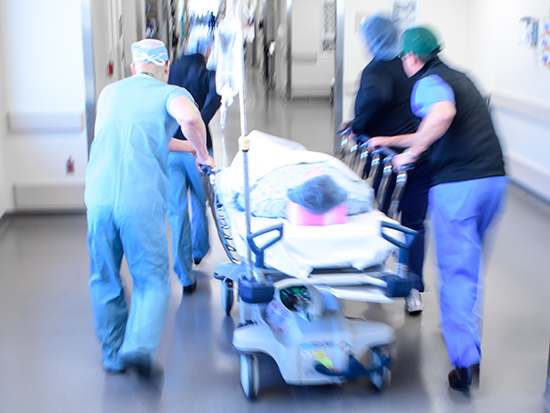Incontinence is the loss of urinary or fecal control, affecting one in six men and one in three women. It can develop at any age, but it tends to be more common later in life. Although often embarrassing, it is highly treatable. Urinary incontinence is the loss of bladder control. Symptoms range from mild leaking to uncontrollable wetting. There are two different types of urinary incontinence. Stress incontinence is caused by weakness in the muscles that keep the bladder closed, which can cause accidents upon laughing, coughing, sneezing, or lifting a heavy object. The second type, overactive bladder, causes a strong urge to urinate, even if there is little to no urine in the bladder. Fecal incontinence is the loss of bowel control. Bowel incontinence can be caused by constipation, damage to structures of the anus and rectum, diarrhea, and pelvic support problems.
UAB Medicine uses a multidisciplinary approach to treat incontinence, working with a variety of experts to establish new therapies for this very common and often embarrassing yet highly treatable condition. Male and female patients of all ages suffering from incontinence are served by one or more departments at UAB, including Urogynecology, Urology, and the UAB Continence Clinic, depending on the exact nature of the condition, the patient’s gender, and whether surgery may be required. Our world-class clinicians work together to provide a comprehensive evaluation for each patient, collaborating when necessary with the UAB Division of Gerontology, Geriatrics, and Palliative Care, and we help train health care providers to recognize, evaluate, and treat incontinence patients.
The National Association For Continence (NAFC) named UAB’s Continence and Urogynecology Care Clinic its first Center of Excellence for Continence Care for 2014-2019. For female patients experiencing incontinence and other pelvic floor disorders, our urogynecology specialists are focused on improving their quality of life with new treatment options, many of which were developed at UAB and don’t always involve surgery. UAB’s Continence Clinic, which cares for both men and women, is one of only eight National Institutes of Health (NIH)-designated Pelvic Floor Disorders Network members, and the clinic has seen more than 6,000 patients since its inception in 1992.
Our active participation in clinical trials means that we continually investigate new drugs and therapies for incontinence, and related research at UAB keeps us on the forefront of important advances and promising new treatments. We have received more than $9 million in research funding, and more than 1,000 clinic patients have participated in related clinical trials, leading to new discoveries and incontinence treatments. This increases the possibility of providing patients with cutting-edge therapies that are not yet available at other medical centers.
A behavioral psychologist works on staff to develop new ways to introduce behavioral treatments and exercises and bladder and bowel control strategies into patient lifestyles to improve their quality of life. In fact, it was UAB Medicine researchers who developed the “freeze and squeeze” urge control method now used nationwide. A UAB study showed that men who do pelvic floor muscle exercises, called Kegel exercises, before prostate cancer surgery regain bladder control faster. Our study also showed that behavioral therapy is more effective than drugs for women with urgency incontinence, as effective as drugs for men with overactive bladder (urgency and frequency of urination), and that it can improve incontinence for men even years after prostate cancer surgery.
Care Providers
Videos

Find a Provider to Schedule an Appointment
Resources
- Urogynecology and Incontinence Testing
- Center of Palliative and Supportive Care
- Integrative Center for Aging Research
- Department of Urology
- Division of Gerontology, Geriatrics, and Palliative Care
- NIH – Incontinence
- National Association for Continence
Related Specialties
Clinical Trials
Speak to your physician about your options and browse the link below for more information
Latest News
View All News-
Three research projects awarded funding from the Immunology Institute Pilot Project program
February 28, 2024
-
UAB’s No Shave November campaign for prostate cancer awareness underway
November 6, 2023
-
Harbert Institute for Innovation and Entrepreneurship names winners of 2023 Innovation Awards
October 31, 2023
-
Prostate cancer: what you need to know
September 14, 2023
-
UAB surpasses 20,000 robotic surgeries milestone, looks to future of continued surgical care
April 28, 2023













